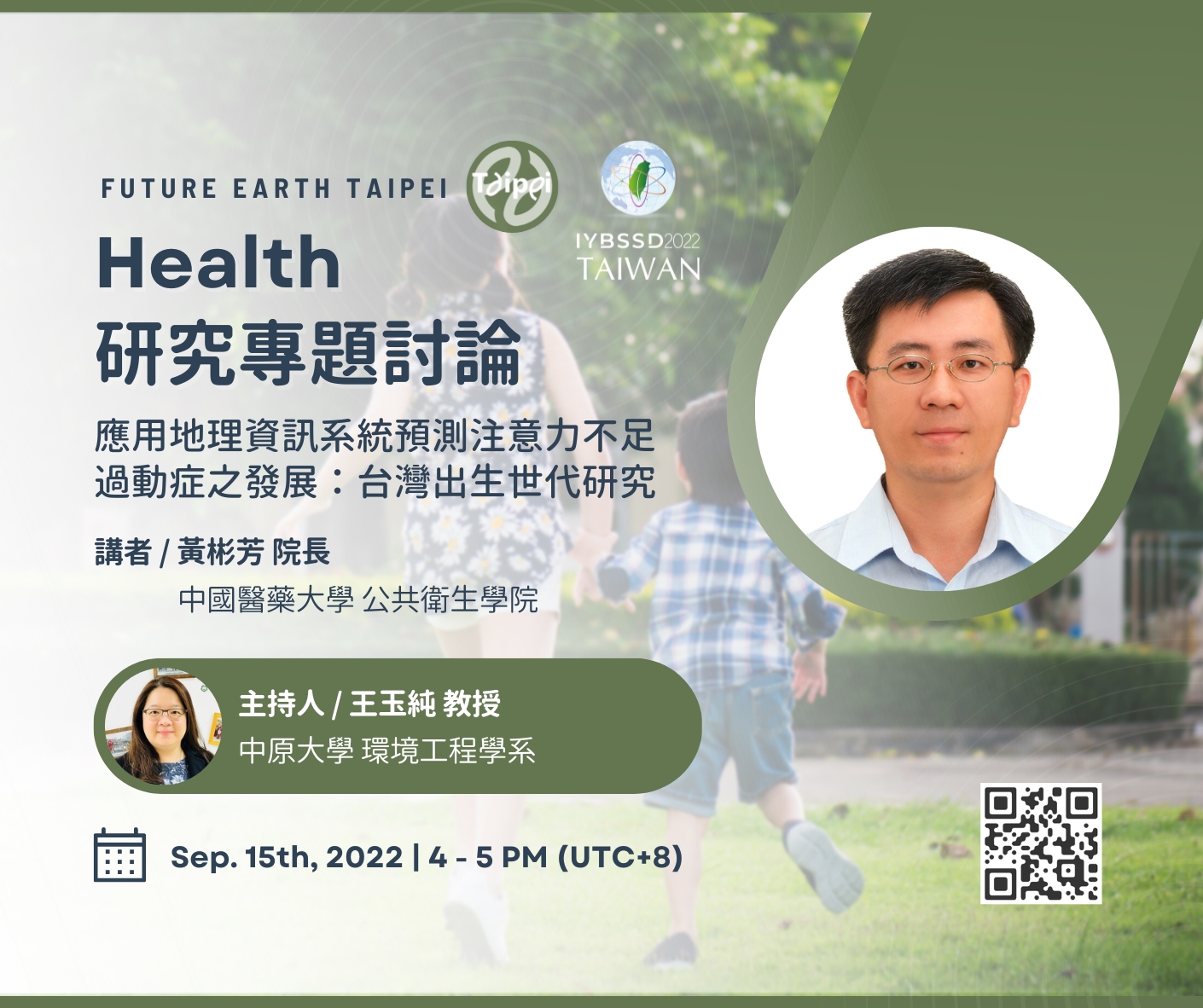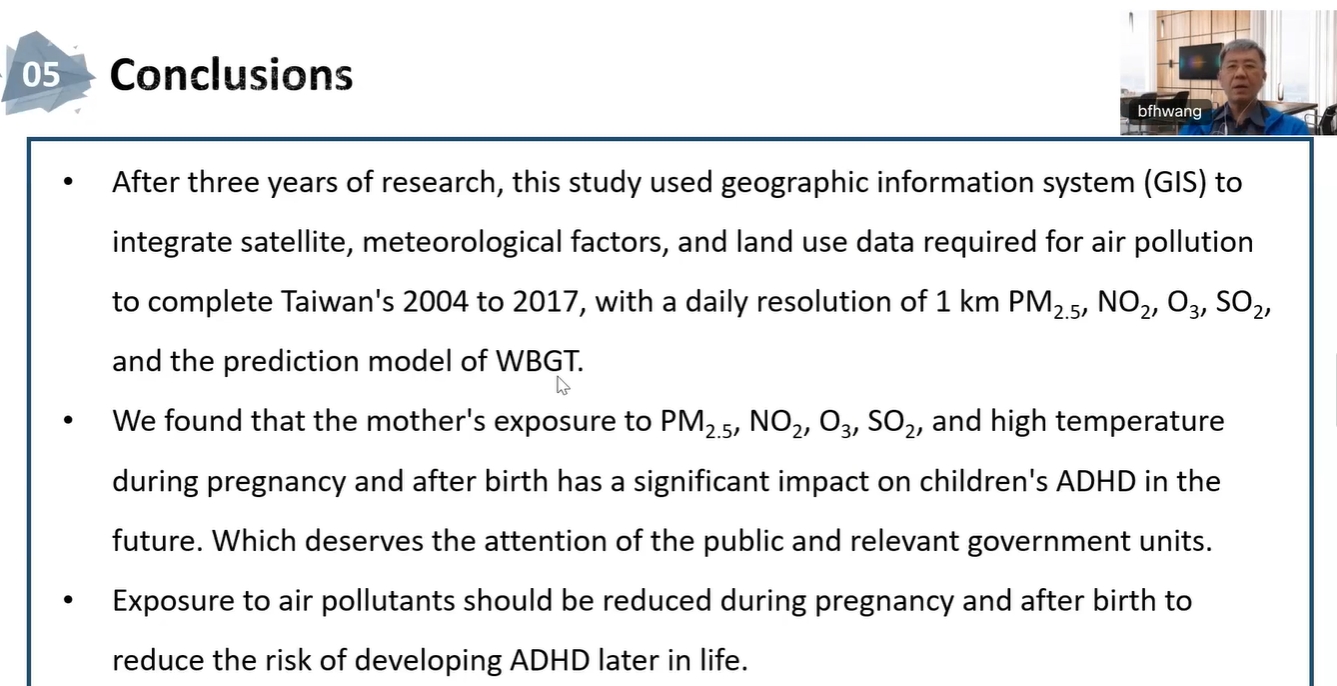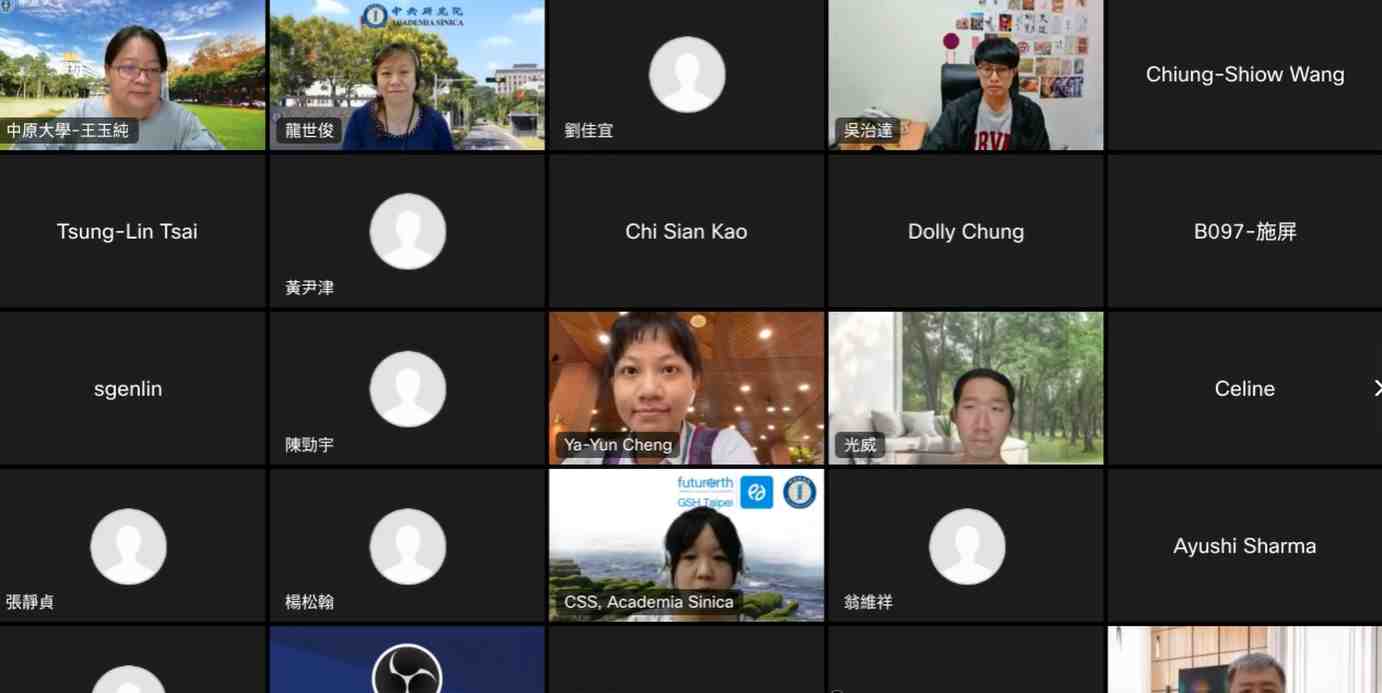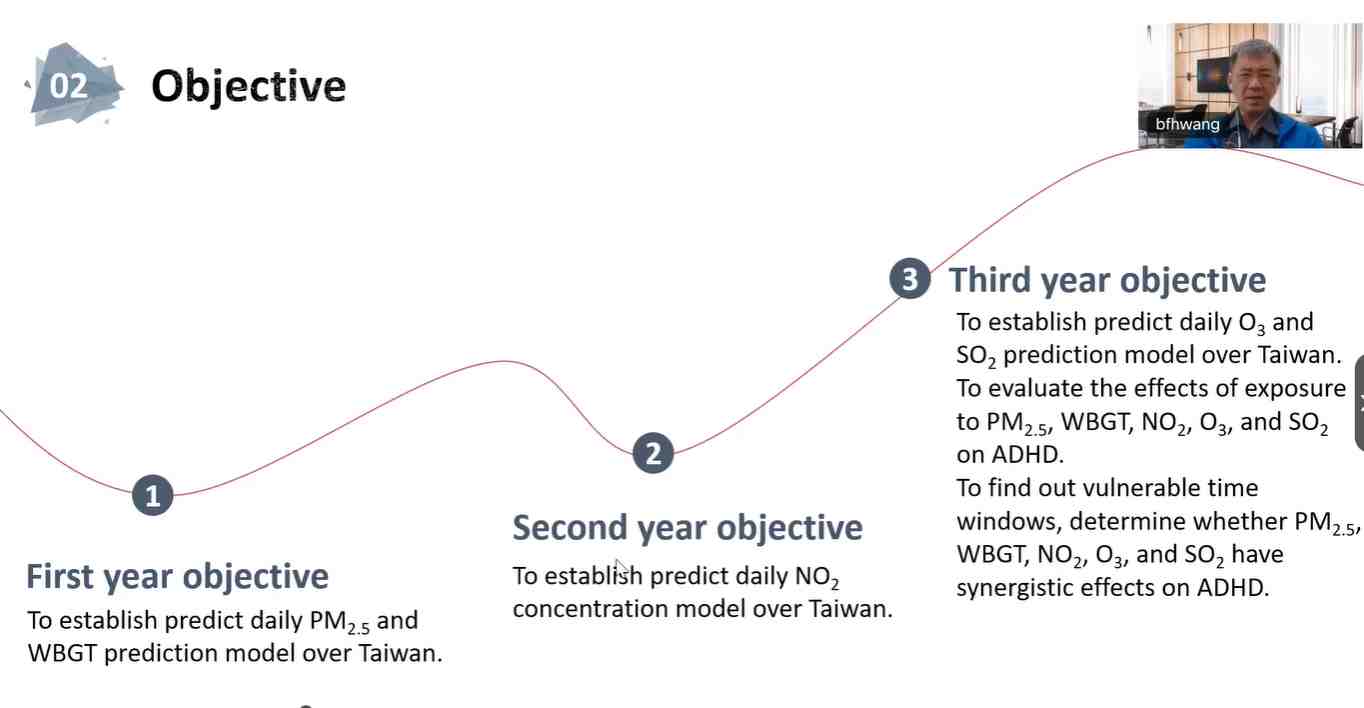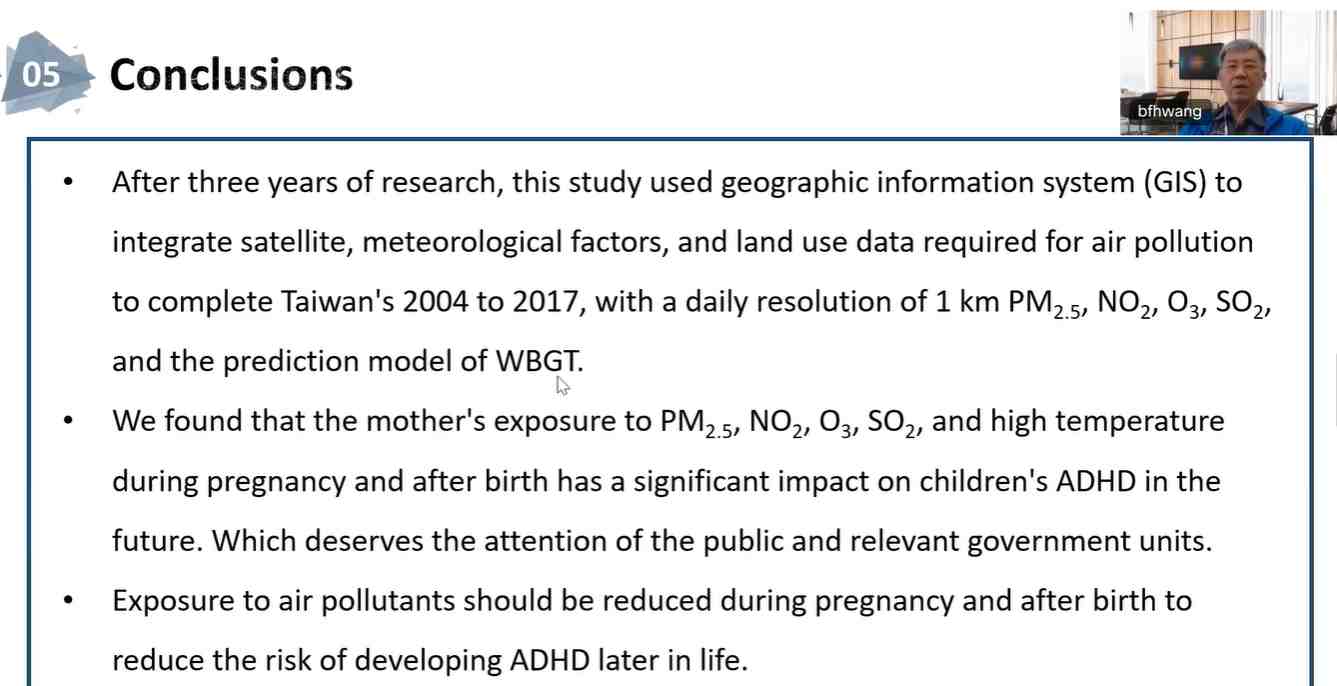Future Earth Health Working Group - 研究專題討論 - 應用地理資訊系統預測注意力不足過動症之發展:台灣出生世代研究
Background and Objective:Attention Deficit and Hyperactivity Disorder (ADHD) is one of the common neurological developmental disorders in children. Studies have investigated the effects of air pollution and high temperature on ADHD, but the results are inconsistent. There is no research in Taiwan using satellite data to explore the effects of fine particulate matter (PM2.5), nitrogen dioxide (NO2), ozone (O3), sulfur dioxide (SO2), and the composite wet-bulb globe temperature (WBGT) on ADHD before and after birth.Methods:This study used Geographic Information Systems (GIS) to integrate satellite, meteorological, and land use data required for air pollution into 1 km grid centroids, and estimated the daily PM2.5, NO2, O3, and SO2 in Taiwan using the Random Forest (RF) and Extreme Gradient Boosting (XGBoost) models. In addition, WBGT was calculated from meteorological factors such as environmental temperature, relative humidity, wind speed, and radiation heat. This study selected the birth cohort from 2005 to 2010, identified ADHD cases, and used time-dependent Cox models and distributed lag non-linear models (DLNMs) to observe the critical periods and dose effects of exposure to PM2.5, NO2, O3, SO2, and WBGT from conception to five years after birth on the risk of developing ADHD.Results:This study took 3 years to complete the prediction models for PM2.5, NO2, O3, SO2, and WBGT. The CV R2 after tenfold cross-validation were 0.84 (RMSE 7.43 ug/m3), 0.83 (RMSE 3.97 ppb), 0.81 (RMSE=0.59 ppb), and 0.68 (RMSE=0.45 ppb), respectively. In addition, there were 8,190 cases of ADHD during the study period. The results showed that exposure to PM2.5 or NO2 during the first trimester and the third year after birth significantly increased the risk of developing ADHD. Exposure to WBGT during the second trimester and the fourth year after birth had a significant positive correlation with ADHD. Exposure to SO2 during the first trimester and after birth had a significant relationship with ADHD. However, exposure to O3 before and after birth had a significant negative correlation with ADHD.Conclusion:This study used GIS to integrate satellite, meteorological, and land use data required for air pollution to complete the prediction models of daily 1 km resolution PM2.5, NO2, O3, SO2, and WBGT in Taiwan from 2004 to 2017. The study found that exposure of mothers to PM2.5, NO2, O3, SO2, and high temperature during pregnancy and after birth significantly affects the risk of developing ADHD in children. It is worth paying attention to by the public and relevant government agencies. It is recommended that pregnant women reduce exposure to air pollutants during pregnancy and after birth to reduce the risk of developing ADHD in their children.
Activity Goals aligned with SDGs Projects

Goal
Public Engagement
Type of event
Seminar/Forum/Lecture
Organizer
Future Earth Taipei Health WG
Taipei Hub
CSS Academia Sinica
Event Audience
Public
Contact
Telephone Number
(02)2787-2536
dolly0105@gate.sinica.edu.tw
Result
Dean Huang Binfang of the School of Public Health of China Medical University: How to apply a geographical information system to study the development of excessive dynamics in Taiwan, Dean Huang's research mainly attempts to solve the problem of environmental flow. Dean Huang's research method is: Applying GIS to Incorporate Remote Sensing, Meteorology, Land Use Data, and AI to Predict The Ground Level of Air Pollutants. This study pointed out: Under a high temperature climate, pregnant women may cause excessive fetal dynamics in the abdomen after exposing these toxic air pollutants. Therefore, this problem is worthy of further monitoring and research on government units to monitor and promote air quality. Dean Huang also suggested that pregnant women should be reduced to areas with high air pollution.
Number of Participants30人
Featured events
Contact Us
- Tel: 02-7749-6818
- Email: iybssdtw@gmail.com
Adviser

自然科學及永續研究發展處
Organizer
國立臺灣師範大學科學教育研究所、自然科學及永續研究推展中心、國立成功大學材料科學及工程學系、台灣物理學會、中國化學會
Co-organizer
中央研究院永續科學中心、中原大學物理學系、中華民國數學會、行政院原子能委員會、財團法人國家實驗研究院國家高速網路與計算中心、財團法人國家衛生研究院、高雄市政府教育局、國立中央大學科學教育中心、國立中正大學科學教育中心、國立成功大學科學教育中心、國立自然科學博物館、國立東華大學科學教育中心、國立科學工藝博物館、國立海洋生物博物館、國立海洋科技博物館、國立高雄大學科學教育中心、國立高雄師範大學、國立清華大學跨領域科學教育中心、國立彰化師範大學、國立臺灣大學科學教育發展中心、國立臺灣科學教育館、國家衛生研究院、淡江大學科學教育中心、逢甲大學綠能科技暨生技產業發展研究中心、臺北市政府教育局、臺灣永續棧、臺灣海洋聯盟、臺灣港務股份有限公司
